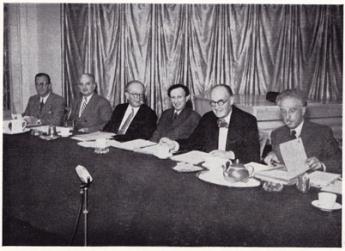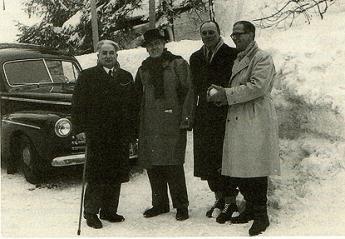Antiquarian Booksellers Conferences 1947-1949

From a Special Correspondent
In 1906 Frank Karslake, a second-hand bookseller, called a few colleagues together and founded the Secondhand Booksellers’ Association. It was the first organization of its kind in the world; but its ambitions and scope were modest. The annual subscription was one shilling, and beyond the obligation to exchange information on bad debtors and book thieves no one seemed at all clear what its purpose was to be.
Tardily other countries followed the British example and, by the time the Second World War ended, there were associations in France, Holland, Denmark, Norway, Sweden, Belgium, Switzerland, Italy and Finland. Many of the countries concerned endured the rigours of enemy occupation; all had after war problems, not the least of which was the treatment of members who had collaborated with the enemy. But there were also problems of exchange control and the regulation of imports and exports, which were new to most European countries. In 1947, therefore, the Dutch association took the initiative by approaching the British, as the senior body, with the suggestion that an international conference should be called, that invitations should be extended to all those countries in which an Association of Antiquarian Booksellers existed, and that delegates should submit the many problems that beset them to a general discussion. The Dutch offered the conference a home in Amsterdam and, in September, 1947, the representatives of nine countries gathered, under the chairmanship of the British president, for the first international conference ever held by the antiquarian book trade. The delegates were unanimous in their desire for the formation of an international body and the British association – the Antiquarian Booksellers’ Association (International) – was entrusted with the task of calling together the presidents of the respective associations to draft a constitution.
The discussions in Amsterdam had been searching and had revealed a divergence of viewpoint on some fundamental issues. These, combined with the difficulty of making mutually convenient arrangements for meeting, and of drafting agenda on the basis of the well-meaning but not fully considered resolutions of the Amsterdam meeting, conspired to prevent the foreshadowed meeting of the presidents. When the second conference was held at Copenhagen a year later, again under British chairmanship, the divergence of views that had been evident at Amsterdam emerged more clearly and for a time it seemed almost as if the International League would be wrecked before it could set sail. The common sense of the delegates, however, and the intense desire of all of them for some form of the international association prevailed in the end. And so, before the Copenhagen conference ended, the International League of Antiquarian Booksellers had not only been formed but had worked out a constitution and elected an executive committee to take in hand various urgent tasks that could be dealt with only on an international basis.
Next week the third conference assembles in London – the first held under the auspices of the League itself. The president, Monsieur W.S. Kundig, of Geneva, in his opening address will be able to present a gratifying report of the first year’s work. Considering that the executive committee is comprised of representatives from Denmark, France, Great Britain, Holland and Switzerland, that all of them are the principals of important bookselling firms with extensive business of their own national association, and that intervals had to be carved in their already fully occupied lives, the record of work undertaken or completed is impressive. Among other things, an International Directory of Antiquarian Booksellers, with their specialities, is almost ready for the printer, and a vocabulary, in seven languages, of more than 1000 terms in general trade use is in an advanced stage preparation.
It has been said that one of the main preoccupations of the founders of the first association of second-hand booksellers was with “bat hats”. The delegates of the international conferences therefore ran true to form in their urgent desire for the preparation of a black list of offending collectors and dealers. The president of the League can report that in almost every instance of financial shortcoming brought to his notice the threat of inclusion in the black list has been sufficient to obtain redress. But it is the hope and intention of the League’s executive that its offices in this connection should not be limited to those of a mere debt-collecting agency. One basic assumption in the formation of the League was that the antiquarian book trade is becoming increasingly conscious of the dignity and high standing of its calling and of the existence of a code of ethics whose efficacy and general applicability lose none of their force by being founded on tradition rather than on the printed word. The broad principles of what constitutes an honest standard of trading have come to be generally accepted by the leading dealers in all countries; and it is significant of the jealous regard for the preservation and even the improvement of the high standard observed by most members of the trade, that the League’s executive has been entrusted with powers of arbitration in international disputes. These powers will be invoked rarely, but it is greatly to be hoped that where the occasion for them does arise decisions will be fearlessly and impartially taken, with regard entirely to principle and not at all to the comparative importance of the persons concerned. For in this respect the League transcends the limits of purely trade concern and offers a service to bibliophiles on both sides of the counter. Indeed, by encouraging the observance of high ethical standards by the trade it will help to further that community of interest between booksellers and collectors which has become almost demonstrably the best hope for the future of the trade itself.
The executive committee of the League is presided over by Monsieur W.S. Kundig, the president of the Swiss association, himself an antiquarian bookseller of world-wide reputation and the son of a bookseller. He was educated in England, which accounts for his remarkable linguistic feat in delivering a long presidential address largely concerned with technical matters in English, which has been the official language of all three conferences. The vice-president is Mr. Percy Muir, of the British firm of Elkin Mathews, Limited, immediate past-president of the ABA, and president of the conferences in Amsterdam and Copenhagen. The League’s treasurer is Mr. Menno Hertzberger, of the International Antiquariaat in Amsterdam, a past president of the Dutch association. The two remaining committee members are M. Andre Poursin, past president of the French association and an antiquarian bookseller in Paris, and Mr. E. Gronholt Pedersen, the popular and apparently permanent president of the Danish association.
These gentlemen are, of course, officers of the League, elected by the general assembly and not representing their national associations. The discussions of the conference are in the hand of delegates appointed by the various associations. The countries represented at the conference, excluding the British hosts, are Belgium (president, M. Florimond Tulkens of Brussels); Denmark (president, Mr. E. Gronholt Pedersen); Finland (president, Mr. Ilmari Jorma of Helsinki); France (president, M.F. de Nobele of Paris); Italy (president, Mr. Aeschlimann of the firm of Ulrich Hoepli in Florence); Norway (president, Mr. J.W. Cappellen of Oslo); Holland (president, Mr. Hertzberger); Sweden (president, Mr. Borjesson); and Switzerland (president, Monsieur W.S. Kundig of Geneva).
(From the Times Literary Supplement on Friday 2nd Sept 49. Special Collections of the University of Amsterdam, Library of the Book Trade, Archive of the International League of Antiquarian Booksellers; shelf number 2.)


